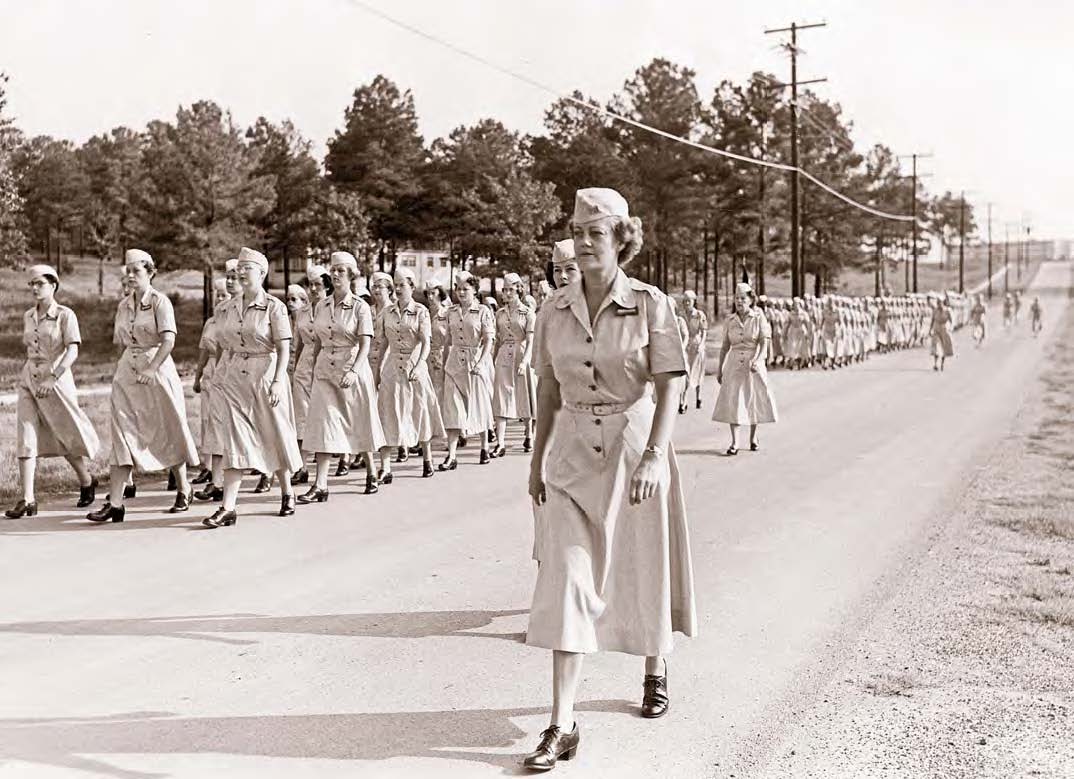By the end of WWII, more than 100,000 women had served in the Corps. Although the WAC became a permanent part of the Army in 1948 and supplied critical noncombat support during the Korean War, the lack of a permanent home for the Corps presented training and organizational challenges. Army officials scoured the country for a location, eventually determining that Alabama’s mild winter temperatures and the proximity of Anniston to regional airports made Fort McClellan the ideal spot. In 1952 Congress approved funds to build the WAC Training Center there, and it opened in 1954 after a multimillion-dollar renovation, ready to house 2,400 enlisted women.
By 1944 more than three hundred women were stationed at Fort McClellan alone, working in mess halls, hospitals, motor pools, and communication divisions.
To alleviate these sorts of anxieties, government recruitment campaigns stressed links between WAC training and acceptable expressions of femininity. For example, as part of “The Big Picture,” a weekly television series that highlighted Army activities, Corps leaders made sure to note that among the first lessons WACs learned at the new facility at Fort McClellan were those in “meticulous grooming and feminine grace.” Narrators of the episode about the new training facility told viewers that appearance was of the utmost importance for the WACs and that the Corps had hired fashion icon Hattie Carnegie to design their uniforms. They focused further attention on the wholesomeness of the facility, where female residents would be encouraged to decorate their rooms, play on the golf course, attend coed dances, and join the WAC band.
Compounding concerns about gender roles and problems with recruitment for the WACs were lingering racial conflicts. ... Though racial problems remained muted through the 1960s, they never disappeared altogether, and they burst to the surface again late in 1971.
WACs encountered a range of experiences between the 1940s and the 1970s. They traveled, learned new skills, faced discrimination, and saw war, serving in Vietnam as they had in all foreign entanglements since the inception of the Corps. But the post-Vietnam era saw significant changes. By that time, the women’s movement had posed serious challenges to traditional gender norms, and WAC basic training had evolved such that it steadily incorporated combat skills. Both the Army and Congress came to recognize the inefficiency and illogic of continuing to segregate women in the service, and consolidated training and the enrollment of women at West Point began in 1976. With women integrated into Regular Army training, a separate WAC unit was no longer necessary. Women began joining their male counterparts at training bases around the country, and on December 1, 1976, the Army transferred the WAC Center from Fort McClellan to Fort Lee in Virginia in preparation for dismantling the Corps altogether. Ironically, only when the task was completed in 1978 did one of the songs of the Fort McClellan WAC band ring true: “The WAC Is a Soldier Too.”
This article was originally published in Alabama Heritage Issue #112, Spring 2014.
Author
Stephanie Chalifoux graduated with her PhD in history from the University of Alabama in 2013 and is currently an adjunct instructor for the history department. Joshua D. Rothman, standing editor of the “Alabama Women” department of Alabama Heritage, is professor of history at the University of Alabama and director of the university’s Frances S. Summersell Center for the Study of the South, which sponsors this department.

 RSS Feed
RSS Feed